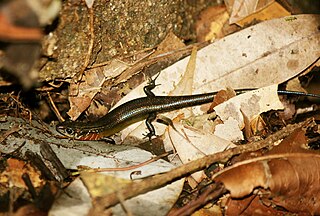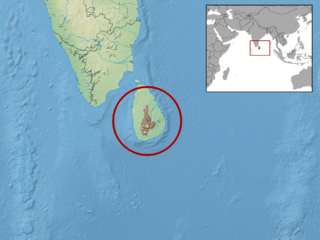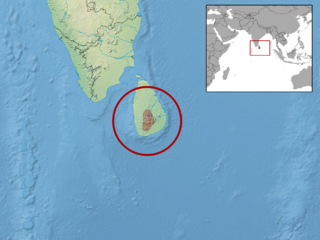
Lankascincus is a genus of lizards, commonly known as lanka skinks and tree skinks, in the family Scincidae. The genus is endemic to Sri Lanka.
Edward Harrison Taylor was an American herpetologist from Missouri.
The Haly's tree skink is a species of lizard in the family Scincidae. The species is native to Sri Lanka. Earlier thought to be found also in the Western Ghats, taxonomic studies have shown D. haliana to be a Sri Lankan endemic, differentiated from the Indian D. subcaeruleum. D. haliana is the only arboreal skink in Sri Lanka.

Sphenomorphus dussumieri, commonly known as Dussumier's forest skink and Dussumier's litter skink, is a species of skink, a lizard in the family Scincidae. The species is endemic to southern India.
Ceratophora karu, also known commonly as Karu's horned lizard or Karunaratne's horn lizard, is a species of lizard in the family Agamidae. The species is endemic to Sri Lanka.
Cyrtodactylus edwardtaylori is a species of Asian bent-toed gecko, a lizard in the family Gekkonidae. The species, which is endemic to Sri Lanka, was originally described by Sri Lankan herpetologists Sudesh Batuwita and Mohomed M. Bahir in 2005.

Cyrtodactylus triedrus, also known as the spotted bent-toed gecko, Sri Lanka gecko, spotted bow-fingered gecko, or spotted ground gecko, is a species of gecko endemic to island of Sri Lanka.
Thwaites's skink, also known commonly as the fourtoe snakeskink, is a species of skink, a lizard in the family Scincidae. The species is endemic to the island of Sri Lanka.

Lankascincus deignani, commonly known as Deignan's tree skink and the Deignan tree skink, is a species of lizard in the family Scincidae. The species is endemic to the island of Sri Lanka.

Lankascincus fallax, also known commonly as the common supple skink and Peters's tree skink, is a species of lizard in the family Scincidae. The species is endemic to the island of Sri Lanka.

Lankascincus gansi, also commonly known as Gans's lankaskink and Gans's tree skink, is a species of lizard in the family Scincidae. The species is endemic to the island of Sri Lanka.

Lankascincus taprobanensis, also known commonly as the Ceylon tree skink and the smooth Lanka skink, is a species of lizard in the family Scincidae. The species is endemic to the island of Sri Lanka.
Lankascincus dorsicatenatus, also known as the catenated lankaskink, is a species of skink, a lizard in the family Scincidae. The species is endemic to island of Sri Lanka.
Eutropis floweri, also known commonly as Flower's skink, Taylor's skink and Taylor's striped mabuya, is a species of lizard in the family Scincidae. The species is endemic to the island of Sri Lanka. It is probably named after Stanley Smyth Flower.
Eutropis madaraszi, also known commonly as the Sri Lanka bronze mabuya, the Sri Lanka bronze skink, or (ambiguously) the spotted skink, is a species of lizard in the family Scincidae. The species is endemic to the island of Sri Lanka.
Nessia burtonii, commonly known as Burton's nessia, Gray's snake skink, or the three-toed snakeskink, is a species of skink, a lizard in the family Scincidae. The species is endemic to the island of Sri Lanka.
Nessia deraniyagalai, commonly known as Deraniyagala's snake skink, Deraniyagala's snakeskink, or Deraniyagala's nessia, is a species of limbless lizard in the family Scincidae. The species is endemic to the island of Sri Lanka.
Nessia didactyla, also known commonly as the two-toed nessia and the two-toed snakeskink, is a species of skink, a lizard in the subfamily Scincinae of the family Scincidae. The species is endemic to the island of Sri Lanka.
Nessia layardi, commonly known as Layard's snake skink or Layard's nessia, is a species of lizard in the subfamily Scincinae of the family Scincidae. The species is endemic to the island of Sri Lanka.
Nessia gansi, also known commonly as Gans's three-toed snake skink, is a species of lizard in the family Scincidae. The species is endemic to the island of Sri Lanka.






